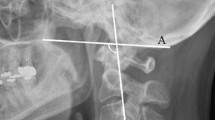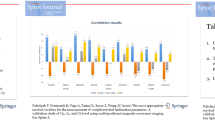Abstract
Background
The description of the measurement technique of the posterior occiput—third cervical spine (OC3) angle—before performing occipitocervical fusion is still controversial. Setting an appropriate alignment in occipitocervical instrumentation is important for successful fixation surgery. Several methods were used for quantifying occipitocervical alignment on the lateral radiograph. This study was performed to describe a measurement technique of OC3 angle and comparing reliability and reproducibility in the measurement of occipitocervical angle with previous method. The purpose of this study was to determine the best technique for assessing this angle.
Materials and methods
Three hundred and twenty-six lateral cervical spine radiographs from volunteers without spinal disorder were taken in neutral position and collected from June 2011 to December 2012. Analysis consisted of measurement of the OC3 angle and posterior occipitocervical angle. Inter- and intra-observer reliabilities were assessed using limit agreement test.
Results
The mean OC3 angle measurements were approximately 107 (94–120) degrees. Intra- and inter-observer error assessed by 95% limit agreement was approximately ±5.5 and ±7.5, while the POCA measurements were approximately 108 (94–120) degrees. Intra- and inter-observer error assessed by 95% limit agreement was approximately ±13.3 and ±18.2.
Conclusion
The OC3 angle measurement is a simple method, good inter- and intra-observer reliabilities to measure of the occipitocervical angle. That can be useful to setting the patient’s position and facilitate confirmation of the occipitocervical neutral position during occipitocervical fusion.




Similar content being viewed by others
References
Aita I, Wadano Y, Yabuki T (2000) Curvature and range of motion of the cervical spine after laminaplasty. J Bone Joint Surg Am 82-a(12):1743–1748
Bobby KT FJ (2011) Injuries of the upper cervical spine. Rothman-Simeone The spine, 6th edn
Clark CR, Goetz DD, Menezes AH (1989) Arthrodesis of the cervical spine in rheumatoid arthritis. J Bone Joint Surg Am 71(3):381–392
Conaty JP, Mongan ES (1981) Cervical fusion in rheumatoid arthritis. J Bone Joint Surg Am 63(8):1218–1227
Deutsch H, Haid RW Jr, Rodts GE Jr, Mummaneni PV (2005) Occipitocervical fixation: long-term results. Spine 30(5):530–535
GB D (2011) arthritic Disorders. Rothman-Simeone THE SPINE, 6th edn, pp 632–650
Grob D (2000) Posterior occipitocervical fusion in rheumatoid arthritis and other instabilities. J Orthop Sci 5(1):82–87
Ichinose K, Kozuma S, Fukuyama S, Goto S, Nagata C, Yanagi F (2002) A case of airway obstruction after posterior occipito-cervical fusion. Masui Jpn J Anesthesiol 51(5):513–515
Izeki M, Neo M, Takemoto M, Fujibayashi S, Ito H, Nagai K, Matsuda S (2014) The O-C2 angle established at occipito-cervical fusion dictates the patient’s destiny in terms of postoperative dyspnea and/or dysphagia. Eur Spine J 23(2):328–336. doi:10.1007/s00586-013-2963-6
Matsunaga S, Onishi T, Sakou T (2001) Significance of occipitoaxial angle in subaxial lesion after occipitocervical fusion. Spine 26(2):161–165
Miyata M, Neo M, Fujibayashi S, Ito H, Takemoto M, Nakamura T (2009) O-C2 angle as a predictor of dyspnea and/or dysphagia after occipitocervical fusion. Spine 34(2):184–188. doi:10.1097/BRS.0b013e31818ff64e
Neo M, Yoshitomi H, Takemoto M, Izeki M (2014) The reinforcement of a C2 laminar screw by a C2 laminar hook as an anchor of occipito-C2 fusion. Eur J Orthop Surg Traumatol 24(4):635–639. doi:10.1007/s00590-013-1349-0
Ota M, Neo M, Aoyama T, Ishizaki T, Fujibayashi S, Takemoto M, Nakayama T, Nakamura T (2011) Impact of the O-C2 angle on the oropharyngeal space in normal patients. Spine 36(11):E720–E726. doi:10.1097/BRS.0b013e3181f9f714
Pan J, Huang D, Hao D, Zhao Y, He B, Wu Q, Li H, Ge C (2014) Occipitocervical fusion: fix to C2 or C3? Clin Neurol Neurosurg 127:134–139. doi:10.1016/j.clineuro.2014.10.013
Phillips FM, Phillips CS, Wetzel FT, Gelinas C (1999) Occipitocervical neutral position. Possible surgical implications. Spine 24(8):775–778
Ranawat CS, O’Leary P, Pellicci P, Tsairis P, Marchisello P, Dorr L (1979) Cervical spine fusion in rheumatoid arthritis. J Bone Joint Surg Am 61(7):1003–1010
Riel RU, Lee MC, Kirkpatrick JS (2010) Measurement of a posterior occipitocervical fusion angle. J Spinal Disord Tech 23(1):27–29. doi:10.1097/BSD.0b013e318198164b
Shoda N, Takeshita K, Seichi A, Akune T, Nakajima S, Anamizu Y, Miyashita M, Nakamura K (2004) Measurement of occipitocervical angle. Spine 29(10):E204–E208
StataCorp (2013) Stata 13 base reference manual. Stata Press, College Station
Stock GH, Vaccaro AR, Brown AK, Anderson PA (2006) Contemporary posterior occipital fixation. J Bone Joint Surg Am 88(7):1642–1649
Acknowledgements
All authors declare no funding source or sponsor involvement in the study design, collection, analysis and interpretation of the data, in writing the manuscript, and in submission of the manuscript for publication.
Author information
Authors and Affiliations
Corresponding author
Ethics declarations
Conflict of interest
All authors declare that they have no conflicts of interests.
Ethical standards
“All procedures performed in studies involving human participants were in accordance with the ethical standards of the institutional and/or national research committee and with the 1964 Helsinki Declaration and its later amendments or comparable ethical standards.”
Electronic supplementary material
Below is the link to the electronic supplementary material.
Rights and permissions
About this article
Cite this article
Kunakornsawat, S., Pluemvitayaporn, T., Pruttikul, P. et al. A new method for measurement of occipitocervical angle by occiput-C3 angle. Eur J Orthop Surg Traumatol 27, 1051–1056 (2017). https://doi.org/10.1007/s00590-016-1881-9
Received:
Accepted:
Published:
Issue Date:
DOI: https://doi.org/10.1007/s00590-016-1881-9




